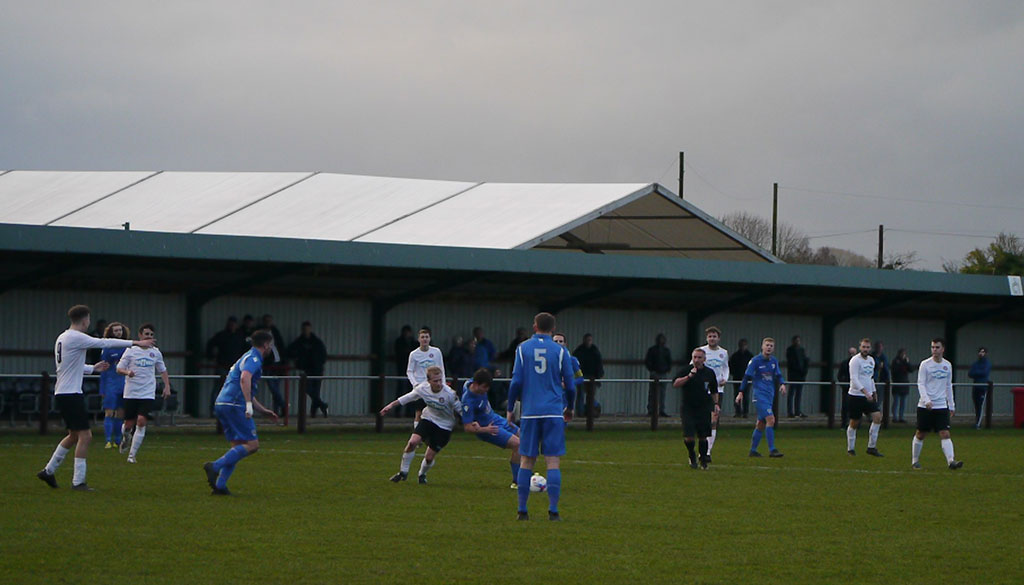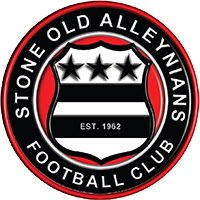
Emblematically Speaking - Stone Old Alleynians
Tue 16th October 2018 | Stone Old Alleynians | By Stewart Taylor
This week we’ll take at look at deciphering the meaning of a club emblem from the opposite direction to the one we normally take.
In other words, we start with a brief explanation of the emblem and then start to work backwards in time to fill in the detail. Sounds a bit odd? Bear with me, all will become clear – I hope!
This paragraph is taken from the matchday programme of Stone Old Alleynians.
“The badge was a direct copy of the Stone Alleynes High School Crest. The Crest for some unknown reason was taken from the Coat of Arms of the Allens family who lived in the county of Sussex in the reign of Anne and George 1. The Crest comprises namely two bars "Argent" and in chief three mullets "Sable".
The Crest is also the same as that of the George Washington family coat of arms but in Black not Red. Because our club was founded by an ex-pupil of Alleynes High School the school badge was adopted to symbolise its ties with the school.
The old club badge was revamped ready for the start of the new 2007/2008 season to the one we see today.”
Sounds reasonable perhaps, but there are a couple of aspects of this which may benefit from further investigation.
Alleyne’s School in Stone (now known as Alleyne’s Academy) has a long and distinguished history, having been founded by Thomas Alleyne in 1558.
Alleyne, a priest by calling, was clearly committed to education in that as well as founding the school in Stone he founded others, which went by the same name, in Uttoxeter and Stevenage. This much is fine.
We now begin to consider the reference to the Coat of Arms of the Allen family of Sussex, and here we may have a problem. It is not known if any of the Alleyne’s schools had a badge of any kind at the time of their founding but, if they did, the reference to the Allen family in the early Georgian period is rather later than the founding of the schools.
However, there is a clue here in that the original name of Alleyne’s School in Stevenage was Master Allen’s School. So what we may well have here is a corruption of the name Alleyne.
Back in those far off days this was not at all unusual as communication was almost exclusively by word of mouth so names regularly crop up with different spellings.
So maybe this is at least part of the reference to the Allen family, but there are no direct references which place Thomas Alleyne in Sussex.
A dead end? Maybe not. If we delve a little deeper we find an Edward Alleyn, sometimes known as Ned Allen, who was an actor in the Elizabethan period and there are two aspects to his life which may help us here.
The first is that Ned, although a Londoner, did have connections to the county of Sussex and, further, he also founded schools in south east London via a vehicle known as Alleyn’s College of God’s Gift charitable foundation.
The schools were known as Alleyn’s School, James Allen’s Girls School and Dulwich College. Note the lack of a letter e at the end of the Alleyn(e) name in this paragraph.
Not conclusive really, perhaps, but there may be enough here for further study.
The reference to George Washington is absolutely fascinating and it is beyond the scope of this short article to go into detail on that subject.
Suffice to say that there is a famous quote attributed to Benjamin Franklin in a play Washington: A Drama in Five Acts which goes something like “"We, and not he—it was unknown to him," Franklin says, "took up his coat of arms, and multiplied and magnified it every way to this, our glorious national banner."
This is taken to mean that the Coat of Arms of George Washington – which goes back to at least the 12th century in Durham – was the origin of the Stars and Stripes flag of the USA.
What we have briefly seen this week is how an emblem can take us to places which we never thought possible, hence the fascination, for some, of the study of emblems.
But before we finish, we go back to the description at the head of this piece which describes bars and mullets.
Whilst bars could reasonably considered to be stripes the classical students of heraldry amongst our loyal readership will immediately recognise that the five rayed device is indeed described as a mullet whereas a six rayed, or above, device is a star.
Perhaps the flag of the USA should be more accurately described as the mullets and stripes – doesn’t quite work does it?
With thanks to Phil Johnson of Stone Old Alleynians FC for providing the description of the club badge used at the top of this article.
 Emblematically Speaking - Stone Old Alleynians
Emblematically Speaking - Stone Old Alleynians
Tue 16th October 2018 | Stone Old Alleynians
By Stewart Taylor

This week we’ll take at look at deciphering the meaning of a club emblem from the opposite direction to the one we normally take.
In other words, we start with a brief explanation of the emblem and then start to work backwards in time to fill in the detail. Sounds a bit odd? Bear with me, all will become clear – I hope!
This paragraph is taken from the matchday programme of Stone Old Alleynians.
“The badge was a direct copy of the Stone Alleynes High School Crest. The Crest for some unknown reason was taken from the Coat of Arms of the Allens family who lived in the county of Sussex in the reign of Anne and George 1. The Crest comprises namely two bars "Argent" and in chief three mullets "Sable".
The Crest is also the same as that of the George Washington family coat of arms but in Black not Red. Because our club was founded by an ex-pupil of Alleynes High School the school badge was adopted to symbolise its ties with the school.
The old club badge was revamped ready for the start of the new 2007/2008 season to the one we see today.”
Sounds reasonable perhaps, but there are a couple of aspects of this which may benefit from further investigation.
Alleyne’s School in Stone (now known as Alleyne’s Academy) has a long and distinguished history, having been founded by Thomas Alleyne in 1558.
Alleyne, a priest by calling, was clearly committed to education in that as well as founding the school in Stone he founded others, which went by the same name, in Uttoxeter and Stevenage. This much is fine.
We now begin to consider the reference to the Coat of Arms of the Allen family of Sussex, and here we may have a problem. It is not known if any of the Alleyne’s schools had a badge of any kind at the time of their founding but, if they did, the reference to the Allen family in the early Georgian period is rather later than the founding of the schools.
However, there is a clue here in that the original name of Alleyne’s School in Stevenage was Master Allen’s School. So what we may well have here is a corruption of the name Alleyne.
Back in those far off days this was not at all unusual as communication was almost exclusively by word of mouth so names regularly crop up with different spellings.
So maybe this is at least part of the reference to the Allen family, but there are no direct references which place Thomas Alleyne in Sussex.
A dead end? Maybe not. If we delve a little deeper we find an Edward Alleyn, sometimes known as Ned Allen, who was an actor in the Elizabethan period and there are two aspects to his life which may help us here.
The first is that Ned, although a Londoner, did have connections to the county of Sussex and, further, he also founded schools in south east London via a vehicle known as Alleyn’s College of God’s Gift charitable foundation.
The schools were known as Alleyn’s School, James Allen’s Girls School and Dulwich College. Note the lack of a letter e at the end of the Alleyn(e) name in this paragraph.
Not conclusive really, perhaps, but there may be enough here for further study.
The reference to George Washington is absolutely fascinating and it is beyond the scope of this short article to go into detail on that subject.
Suffice to say that there is a famous quote attributed to Benjamin Franklin in a play Washington: A Drama in Five Acts which goes something like “"We, and not he—it was unknown to him," Franklin says, "took up his coat of arms, and multiplied and magnified it every way to this, our glorious national banner."
This is taken to mean that the Coat of Arms of George Washington – which goes back to at least the 12th century in Durham – was the origin of the Stars and Stripes flag of the USA.
What we have briefly seen this week is how an emblem can take us to places which we never thought possible, hence the fascination, for some, of the study of emblems.
But before we finish, we go back to the description at the head of this piece which describes bars and mullets.
Whilst bars could reasonably considered to be stripes the classical students of heraldry amongst our loyal readership will immediately recognise that the five rayed device is indeed described as a mullet whereas a six rayed, or above, device is a star.
Perhaps the flag of the USA should be more accurately described as the mullets and stripes – doesn’t quite work does it?
With thanks to Phil Johnson of Stone Old Alleynians FC for providing the description of the club badge used at the top of this article.


